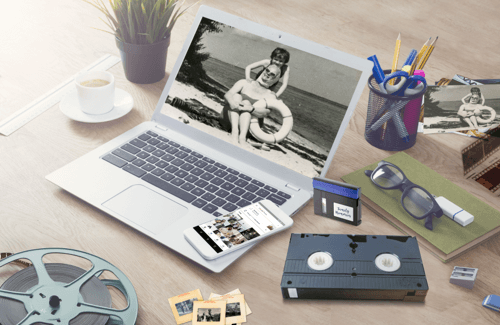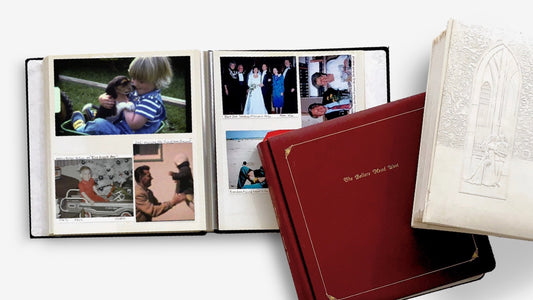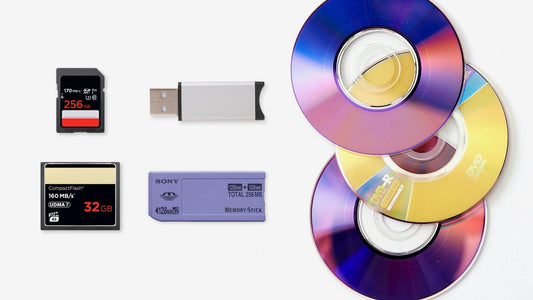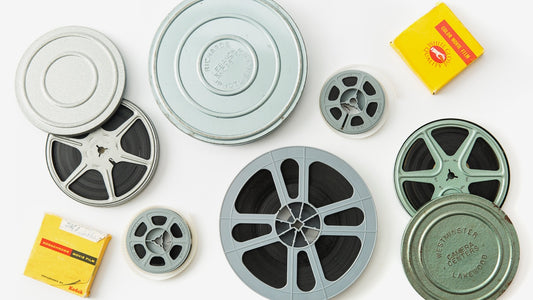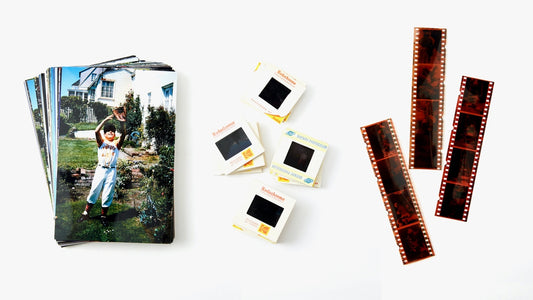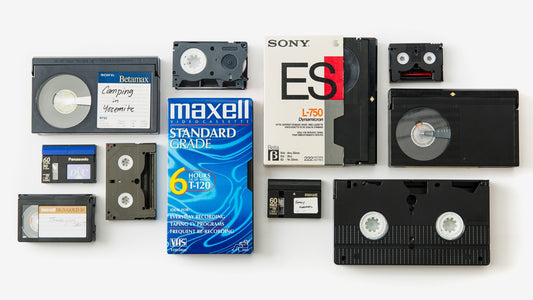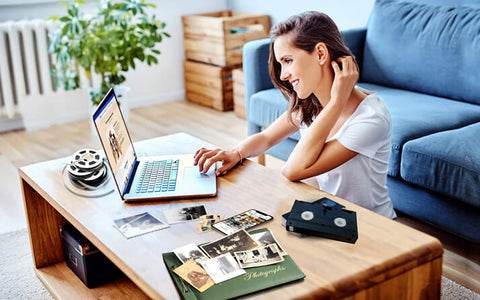Walking into a craft store and seeing an entire aisle dedicated to scrapbook albums can feel a little overwhelming. They come in all shapes, sizes, and materials, and it’s hard to know where to even begin. Should you get a big one or a small one? A binder or a spiral-bound book? The good news is that it doesn’t have to be a complicated decision. The perfect album for your project is out there, and finding it just comes down to understanding your own needs. This guide will break down the key features to look for, helping you cut through the noise and choose an album with confidence.
Key Takeaways
- Choose Archival Quality for Longevity: The most critical feature of any album is its ability to protect your photos. Always select one with acid-free and lignin-free materials to prevent your pictures and pages from yellowing over time.
- Select a Binding That Fits Your Story's Future: Think about whether your project is a one-time creation or an ongoing collection. A post-bound album offers a polished, finished look, while a D-ring binder gives you the flexibility to add more pages as you make new memories.
- Consider Size and Scope Before Style: Before you choose a cover, decide on a practical size for your project. A massive album might be hard to store and share, so pick a dimension that fits your story and is easy for your family to enjoy.
What is a Scrapbook Album?
Think of a scrapbook album as the home for your memories. It’s more than just a book to stick photos in; it’s a creative space where you can bring your stories to life. Scrapbook albums are specifically designed to help you organize and display not just your favorite pictures, but also ticket stubs, handwritten notes, and other little pieces of your life. It’s your personal, tangible history book that you get to design from cover to cover.
Choosing the right album is the first, and arguably most important, step in your scrapbooking project. The album itself sets the stage for your layouts, protects your precious photos, and determines how your finished project will look and feel on your bookshelf. Before you even think about paper and embellishments, you need a sturdy, reliable foundation. And while you're gathering your physical photos, it's also a great time to think about creating digital backups. Services like photo transfer can give you peace of mind by digitizing your prints, ensuring they’re safe no matter what.
Traditional vs. Modern Albums
When you start shopping, you’ll likely see two main styles: traditional and modern. Traditional albums, like post-bound or 3-ring binders, are the classics for a reason. They are often expandable, allowing you to add more pages as your collection of memories grows. Modern albums, on the other hand, might include things like pre-made chipboard books or "smash books" that encourage a more free-form, artistic approach. There’s no right or wrong choice here; it really comes down to your personal style and the kind of story you want to tell. You can find a wide variety of scrapbook albums online to see which style speaks to you.
Common Album Sizes
Scrapbook albums come in several standard sizes, each suited for different types of projects. The most popular size is 12x12 inches, which gives you plenty of space for large photos and creative layouts. Another common option is 8.5x11 inches, the size of standard letter paper, which is great for printing journaling directly from your computer. You’ll also find smaller sizes like 8x8 and 6x8 inches, which are perfect for themed albums—like a baby’s first year or a specific vacation—or for creating a heartfelt gift. If you have older, completed albums, consider using an album scanning service to create a digital version you can easily share with family.
Album Materials and Quality
This is where you want to pay close attention. The quality of your album materials directly impacts how well your memories are preserved. Always look for albums and pages that are labeled "photo-safe," "acid-free," and "lignin-free." These terms mean the materials won't break down over time and cause your photos to yellow or fade. It can be tempting to grab a cheaper album, but investing in a high-quality one is one of the best ways to protect your hard work and your irreplaceable photos. Avoiding common scrapbooking mistakes like using the wrong materials will ensure your scrapbook lasts for generations.
Types of Scrapbook Albums
Choosing a scrapbook album is like picking the perfect home for your most treasured memories. The right one will not only protect your photos and keepsakes but also complement the story you’re telling. With so many options available, it’s helpful to understand the basic types and what makes each one unique. Your choice will likely come down to your project's scope, how often you plan to add to it, and your personal style. Think about whether you're creating a single, finished project or an ongoing collection that will grow over the years.
Whether you’re creating a family history book with recently digitized photos from your old home movies or documenting a recent vacation, there’s an album style built for the job. The most common types you’ll find are post-bound, 3-ring, spiral-bound, and D-ring albums, along with specialty albums designed for specific themes. Each offers a different approach to flexibility, durability, and presentation. Understanding the pros and cons of each will help you select a scrapbook that not only looks great on your coffee table but also stands the test of time. Let’s look at what sets them apart so you can find the best fit for your precious moments.
Post-Bound Albums
Post-bound albums offer a classic, seamless look that resembles a professionally bound book. Instead of rings, these albums use a set of screw posts to hold the pages together. This design allows the pages to lay relatively flat, creating a beautiful, uninterrupted two-page spread. While you can add more pages by purchasing post extenders, it’s a bit more involved than snapping open a binder. These albums are a wonderful choice if you want a polished, traditional finish for a completed project, like a wedding album or a baby’s first year book.
3-Ring Binders
If you love flexibility, a 3-ring binder might be your perfect match. Just like the binders you used in school, these albums make it incredibly easy to add, remove, and rearrange pages. This is ideal for ongoing projects, like a family yearbook, where you’ll be adding new memories over time. They come in a huge variety of sizes and styles, so you can easily find one that fits your aesthetic. The only downside is the gap between pages created by the rings, but for many scrapbookers, the convenience is well worth it.
Spiral-Bound Albums
Spiral-bound albums are typically more compact and come with a fixed number of pages. Their biggest advantage is that the pages can be folded back on themselves and lay perfectly flat, which makes them very easy to work on and display. Because you can’t add or remove pages, they are best suited for smaller, self-contained projects with a clear beginning and end. Think of them as perfect for a vacation scrapbook, a tribute to a beloved pet, or a thoughtful, handmade gift for a friend. Their simple, no-fuss design makes them an approachable option for new scrapbookers.
D-Ring Albums
A D-ring album is a modern update to the traditional 3-ring binder. As the name suggests, the rings are shaped like the letter "D" instead of a circle. This clever design allows the pages to lie flat against the back cover, preventing them from bending or curling near the spine. D-ring albums can also hold more pages than a standard round-ring binder of the same size, making them a great option for larger projects. They offer the same flexibility as a 3-ring binder but with a cleaner look and better page protection for your cherished photos.
Specialty & Themed Albums
For those with a specific event in mind, specialty and themed albums can be a fantastic starting point. You can find albums designed for everything from weddings and new babies to travel and holidays. These often come with pre-designed pages, coordinated color schemes, and unique embellishments that help you create a cohesive story with less effort. Using a themed album is a great way to ensure your final project looks polished, especially if you’re new to scrapbooking or want to find inspiration for your layout.
Key Features to Look For
Once you have a handle on the basic types of albums, you can start looking at the specific features that make a scrapbook a lasting home for your memories. The right details can make all the difference between an album that falls apart and one that becomes a family heirloom. Think of it like buying a house for your photos—you want a solid foundation, good protection from the elements, and a style that feels like home. Let's walk through the most important features to keep an eye on.
Binding Style and Durability
The binding is the backbone of your album, holding everything together. A weak binding can lead to lost pages and a frustrating crafting experience. Post-bound and 3-ring albums are popular because they’re sturdy and often expandable. When you’re shopping, open the album and see how it lays. Does it lie flat for easy viewing and scrapbooking? A durable binding ensures your pages stay secure and your finished album can withstand being passed around and enjoyed for years. Don't get stuck with a binding that's too small for your project or too flimsy to last; choosing the right binding style is your first step toward a successful project.
Page Protection
Your photos are the heart of your scrapbook, so protecting them is a top priority. Most quality albums come with page protectors, which are clear plastic sleeves that shield your layouts from fingerprints, dust, and spills. Look for protectors that are clear, non-glare, and made from archival-safe materials like polypropylene. Avoid those old, sticky-page magnetic albums, as the adhesive can damage photos over time. Using photo-safe materials is non-negotiable if you want your pictures to stay vibrant. Remember, the ultimate protection is a digital backup. Services like YesVideo’s photo transfer can create a digital copy of your most precious prints before you even put them on the page.
Cover Material and Construction
The cover is your album's first impression, and it’s also its first line of defense. Covers come in a variety of materials, including fabric, leather, faux leather, and bookcloth. A sturdy, well-constructed cover will protect the pages inside from damage. Think about how and where you'll store the album. A durable leather or bookcloth cover might be best for a coffee table book, while a simple, clean cover might suit a shelf of family albums. This is also where you can let your personality shine. Choosing a cover that reflects your personal style makes the album feel uniquely yours from the moment you pick it up.
Why Acid-Free Matters
You’ll see the term "acid-free" everywhere in the scrapbooking world, and for good reason. Paper and adhesives containing acid will turn yellow and brittle over time, and they can transfer that acid to your photos, causing them to fade and deteriorate. Always choose albums, papers, and adhesives that are labeled "acid-free" and "lignin-free." Lignin is a natural compound in wood pulp that also causes paper to become acidic and yellow. Using archival-quality materials is the single most important thing you can do to ensure your scrapbook stands the test of time. It’s a simple choice that makes a huge difference in preserving the color and quality of your cherished photos.
Room to Grow: Album Expandability
Your story isn't finished, and your scrapbook album shouldn't have to be, either. Many projects end up bigger than originally planned. Choosing an expandable album, like a post-bound or D-ring binder, gives you the flexibility to add more pages as you gather more memories. This saves you from having to start a whole new album for the same event or theme. Before you buy, think about the potential scope of your project. It’s always better to have a little extra room than to run out of space. This foresight helps you stay organized and ensures your album can grow right alongside your family's story.
How to Choose the Perfect Album
Picking the right scrapbook album is the first step in creating a home for your most treasured memories. With so many options out there, it can feel a little overwhelming, but it really comes down to what you need for your specific project. Think of it like choosing a frame for a masterpiece—the album should complement and protect the story you’re telling inside. By considering a few key factors, you can find the perfect album that not only looks great but also stands the test of time, keeping your photos and keepsakes safe for years to come.
Consider Your Project's Size
Before you fall in love with a cover design, think about the scope of your project. Are you creating a small album for a weekend trip or a comprehensive family history book? The size of your album matters. A large, bulky album might be perfect for a coffee table, but it’s not ideal if you plan to carry it around to share with family. As some experts advise, you don't want an album that's too big for its purpose. A standard 12x12 inch album offers plenty of space for creative layouts, while smaller sizes like 8x8 or 6x8 are more portable and great for themed projects.
Plan for More Memories
Your story doesn't end when you fill the last page. Life keeps happening, and you’ll want to add new memories as they’re made. This is where expandability comes in. Many post-bound and D-ring albums allow you to add more pages, so your scrapbook can grow with you. When you’re shopping, check to see if the manufacturer sells refill pages that match the album. This flexibility means you won’t have to start a new album every year; you can simply add to the one you already have, keeping your memories beautifully organized in one place.
Decide on Protection Needs
The whole point of a scrapbook is to preserve your memories, so don't let the materials work against you. To keep your photos from fading or deteriorating, always choose albums with acid-free, lignin-free, and PVC-free pages. These archival-quality materials won't damage your photos over time. It’s also important to use photo-safe alternatives to glue, like photo corners or acid-free adhesive. Taking a moment to check for these features ensures your hard work and precious moments are protected for future generations to enjoy.
Match Your Personal Style
This is the fun part! Your scrapbook is a reflection of you, so pick an album that matches your personality and the theme of your memories. Do you love a clean, modern look, or is a rustic, vintage vibe more your speed? You can find scrapbook albums based on themes like family, holidays, travel, and weddings. Whether you choose a simple linen cover you can customize yourself or a beautifully decorated themed album, make sure it’s a style you’ll love looking at for years to come. The cover is the first thing people will see, so let it set the tone for the beautiful story inside.
Set Your Budget
Creating a beautiful scrapbook doesn’t have to be expensive. Albums come in a wide range of prices, so you can definitely find something that fits your budget. Simple, smaller albums can cost just a few dollars, while larger, high-quality albums with leather covers might be more of an investment. Most standard albums are priced between $15 and $35. Setting a budget beforehand helps you narrow your choices and focus on finding the best quality album in your price range. Remember to also factor in the cost of any refill pages or page protectors you might need.
Your Smart Shopping Guide
Now that you know what to look for, let's get to the fun part: shopping! Finding the right album doesn't have to be complicated or expensive. With so many options available, it helps to have a plan. This guide will walk you through where to look, what to pay, and how to find the best deals, so you can feel confident in your choice. Think of it as your roadmap to finding the perfect home for your most treasured memories, whether they're recent snapshots or photos from old family videotapes you've recently digitized.
A little bit of smart shopping ensures you get a high-quality album that not only looks great but also stands the test of time. After all the effort you put into creating your scrapbook, the album itself should be just as special. Let’s break down how to find exactly what you need without the guesswork.
Top Brands to Consider
When you start browsing online or walking down the craft store aisle, you'll see a few names pop up again and again. Brands like Pioneer, Simple Stories, Doodlebug, and 49 And Market are well-known in the scrapbooking community for their quality and beautiful designs. They offer a wide variety of styles, from classic and elegant to modern and playful. Many online retailers, like Scrapbook.com, also have their own trusted lines of albums that are worth checking out. Starting with these reputable brands is a great way to ensure you’re getting a durable product that will keep your memories safe for years to come.
What to Expect to Pay
You don't need to break the bank to get a beautiful, long-lasting album. Most standard 12x12 inch albums fall in the $15 to $35 range. Of course, you can find more elaborate, high-end options with premium materials like leather, but there are plenty of fantastic and sturdy choices right in that budget-friendly sweet spot. Refill pages are usually sold separately and can cost just a few dollars per pack. Remember that the album is an investment in protecting your memories, so it's worth choosing quality over the absolute lowest price tag.
Where to Find Quality Albums
You can find a great selection of scrapbook albums at big-box craft stores like Hobby Lobby and Michaels, as well as specialized online shops. These stores typically carry the most popular sizes, like the classic 12x12 inch, as well as smaller 8.5x11 and 6x8 inch options. Before you start filling your album, it's a great idea to gather all your photos. If you have boxes of old prints or slides, using a photo transfer service can help you digitize everything first. This makes it much easier to sort through decades of memories, select your absolute favorites, and print fresh copies for your project.
The Best Times to Buy
A little patience can save you a lot of money. Craft stores frequently run sales on scrapbooking supplies, so it’s rare that you’ll have to pay full price if you can wait. Keep an eye out for weekly ads and promotions, where albums and accessories are often reduced by 40% or more. Major holidays and the changing of seasons are also popular times for stores to offer deep discounts. Signing up for your favorite store's email newsletter is a simple way to get notified about upcoming deals so you never miss a chance to save.
How to Find Deals and Discounts
Beyond waiting for a big sale, you can find great deals by looking for bundled kits. These often include an album and a starter set of page protectors, which is usually cheaper than buying them separately. Don't forget to check the clearance aisle—you can often find beautiful albums with discontinued cover designs at a steep discount. If you're working with fragile, aging family photos from an old album, consider using an album scanning service to preserve the original layouts digitally. This gives you a backup of those precious pages before you handle the photos for your new scrapbook.
Make It Your Own: Customization Options
Once you’ve picked the right album structure, the real fun begins: making it a true reflection of your memories. Customization is what turns a simple collection of photos into a personal story. This is your chance to let your creativity shine and design a keepsake that feels uniquely yours. From the cover that greets you to the little details on each page, every choice you make adds another layer to the story you’re telling. Think of your album as a blank canvas and your photos, papers, and embellishments as your palette.
Customizing the Cover
The cover is the first thing you and your loved ones will see, so make it special! Many albums come with a small window on the front, perfect for showcasing a favorite photo that captures the theme of the entire book. You can also create a title using letter stickers, die-cuts, or even your own handwriting. Don’t be afraid to add a personal touch with decorative paper, washi tape, or other stickers that match your style. A beautifully customized cover sets the tone for the cherished memories held inside and makes your album an inviting piece to display in your home.
Flexible Page Layouts
How you arrange your photos on the page guides the story. You can find albums in popular sizes like 12x12 or 8.5x11 inches, which give you plenty of room for multiple photos and decorative elements. Smaller albums, like 6x8 inches, are great for simpler projects or themes. Many scrapbookers use page protectors with built-in pockets, allowing you to easily slide photos into place. Before you commit your original pictures to the page, consider creating a digital backup with a photo transfer service. This gives you peace of mind and the freedom to experiment with your layouts without risking your only copies.
Choosing a Theme
A theme acts as the glue that holds your scrapbook together, creating a cohesive and polished look. Your theme can be based on an event, like a wedding or a birthday, or a broader concept, like a family year-in-review or a travel journal. Once you have a theme, it becomes easier to choose a consistent color palette, paper style, and embellishments. You can find albums specifically designed for popular themes like holidays or new babies, which often come with coordinating papers and stickers to get you started. A clear theme helps you make design decisions and tells a more focused story.
Working with Mixed Media
Your memories aren't just photos—they’re ticket stubs, handwritten notes, postcards, and other little treasures. Incorporating these items, a practice known as mixed media, adds texture and a deeper personal connection to your pages. When you include bulkier items, a post-bound or D-ring album is a great choice because it can easily expand. Before you glue down a one-of-a-kind keepsake, it’s a smart idea to preserve it digitally. An album scanning service can create high-quality digital copies of your memorabilia, ensuring those irreplaceable pieces are safe forever.
Adding Creative Touches
The final details are what make your scrapbook truly special, but it’s easy to go overboard. The most common mistake new scrapbookers make is using too many decorations, which can overwhelm the photos. Instead, focus on simple, meaningful touches. A handwritten caption telling the story behind a photo is often more impactful than a dozen stickers. Try adding a simple paper border to make a photo pop or use stamps to create a subtle pattern. The goal is to enhance your memories, not compete with them. Let your photos be the star of the show.
Protect Your Finished Scrapbook
You’ve spent hours carefully choosing photos, arranging layouts, and journaling your favorite stories. Now that your scrapbook is complete, the final step is making sure it lasts for generations to come. Proper care and storage are just as important as the creation process itself. A finished scrapbook is a treasure, and like any valuable item, it needs protection from damage, aging, and accidents. By taking a few simple precautions, you can ensure your hard work remains a beautiful keepsake that your family can enjoy for years.
Think of your scrapbook as a time capsule. Its pages hold not just pictures, but feelings, moments, and memories. Protecting it means preserving that legacy. From where you store it to how you handle it, every detail matters. The good news is that it doesn't require a lot of effort—just a little bit of mindfulness. Let's walk through the best ways to care for your finished album so it stays in pristine condition.
How to Store Your Album
Where you keep your scrapbook has the biggest impact on its longevity. Find a cool, dry, and dark place, like a closet shelf in a main living area or a sturdy archival box under a bed. Avoid attics and basements, where temperature and humidity can fluctuate dramatically and cause damage. It’s also a good idea to store your albums flat rather than standing them up on a bookshelf. Storing them horizontally prevents the pages from sagging and putting stress on the binding over time. If you have multiple albums, try not to stack too many on top of each other to avoid excessive weight.
Tips for Handling
Every time you share your scrapbook, you create a new memory. To keep it safe during viewing, always handle it with clean, dry hands to avoid transferring oils and dirt to the pages. When you open the album, support the spine and covers so they don't bend back too far. Encourage little ones to be gentle as they turn the pages. The materials you used during creation also play a role here; using photo-safe adhesives from the start ensures that photos and embellishments stay put and don't cause damage as the album is handled over the years.
Mind the Environment
Your scrapbook’s worst enemies are light, moisture, and extreme temperatures. Direct sunlight is especially harmful, as its UV rays can quickly fade your photos and cause the paper to become brittle and yellow. That’s why a dark closet or box is ideal. Humidity is another major concern, as it can make pages warp, stick together, or even grow mold. If you live in a particularly humid climate, consider placing a silica gel packet near your stored albums to absorb excess moisture. Keeping your albums inside your home's main living space helps maintain a stable, controlled environment.
Simple Maintenance
A little upkeep goes a long way. Once or twice a year, take a few minutes to check on your scrapbooks. Gently dust the covers with a soft, dry cloth. Carefully flip through the pages to make sure all the photos and embellishments are still secure. If you notice anything coming loose, you can re-adhere it with a bit of acid-free glue. This quick check-up helps you catch small issues before they become bigger problems. It’s also a wonderful excuse to revisit your favorite memories and appreciate the stories you’ve preserved.
Long-Term Care for Your Memories
Even with perfect storage and handling, physical albums are susceptible to accidents and the slow march of time. The ultimate way to protect your work is to create a digital backup. Before you even begin a project, digitizing your original photos is a fantastic first step. For the finished product, consider a professional album scanning service. This creates a high-quality digital copy of each completed page, preserving your layouts, journaling, and all. A digital version ensures your memories are safe from fire, water damage, or loss, and makes it incredibly easy to share your entire creation with family and friends anywhere in the world.
Common Mistakes to Avoid
Creating a scrapbook is a labor of love, but a few common missteps can get in the way of making a beautiful, lasting keepsake. By knowing what to watch out for from the start, you can ensure your album protects your memories and tells your story exactly the way you want. Let’s walk through some of the most frequent mistakes and how you can easily sidestep them.
Choosing the Wrong Size
It’s easy to get excited and grab the first beautiful album you see, but size really does matter. An oversized album might seem like a great idea for fitting lots of photos, but consider where you’ll store it and how you’ll share it with others. If an album is too big and bulky, it can be difficult to handle and might end up tucked away in a closet. On the other hand, a small album can feel restrictive. Think about the scope of your project and choose a size that feels manageable and fits the story you want to tell.
Ignoring Material Quality
The materials you use are just as important as the photos themselves. Using the wrong adhesives, like standard craft glue or tape, can cause your precious photos to yellow and deteriorate over time. Always look for materials labeled "photo-safe" and "acid-free." This goes for everything from the album pages to the glue, pens, and decorative paper you use. Investing in quality supplies ensures your scrapbook will last for generations. For ultimate peace of mind, consider creating a digital backup by scanning your photo albums before you even begin.
Forgetting About Protection
A scrapbook album’s primary job is to protect its contents. A common mistake is choosing an album based on looks alone, without checking its protective features. The best albums have pages made from archival-quality, acid-free paper to prevent fading and discoloration. Many also come with page protectors that offer UV resistance, shielding your photos from light damage. Don’t let your hard work and cherished memories fade away; always check that your album is designed for long-term preservation.
Miscalculating Your Budget
The world of scrapbooking supplies is vast and tempting. It’s a big mistake to start buying materials without a plan, as you can easily overspend on items you may never use. Before you shop, outline your project and make a list of what you truly need. Set a realistic budget for your album and essential supplies first. You can always add more decorative elements later. Planning your budget helps you focus on what’s important and prevents your craft corner from turning into a stockpile of unused stickers and paper.
Limiting Your Design
Many people get stuck trying to make every page perfect, but scrapbooking is about storytelling, not perfection. Don’t feel pressured to follow rigid design rules or make every layout look like it’s from a magazine. Your scrapbook should reflect your personality and the genuine emotions behind the photos. Embrace imperfection, mix up your layouts, and let the story guide your creativity. The most memorable scrapbooks are the ones that feel personal and authentic, so have fun with the process and let your memories shine.
Related Articles
Frequently Asked Questions
If I can only focus on one thing, what's the most important feature of a good scrapbook album? Without a doubt, the most critical feature is archival quality. Always look for albums and pages that are labeled "acid-free" and "lignin-free." This isn't just fancy jargon; it means the materials won't break down over time and cause your precious photos to turn yellow or fade. Choosing a photo-safe album is the single best thing you can do to ensure your memories look just as vibrant decades from now as they do today.
What's the real difference between a scrapbook album and a regular photo album? Think of it as the difference between a storage container and a custom-built home. A regular photo album is primarily for storing pictures, often in simple plastic sleeves. A scrapbook album, on the other hand, is a creative canvas designed to tell a story. It provides the space and the right materials to combine photos with journaling, ticket stubs, and other keepsakes, all while ensuring everything is preserved safely for the long haul.
I'm just starting out. Which type of album is best for a beginner? A 3-ring or D-ring binder is a fantastic choice for your first project. The main reason is flexibility. These albums make it incredibly easy to add, remove, and rearrange pages as you go, so there's no pressure to get everything perfect on the first try. This freedom allows you to experiment with your layouts and add new memories as they happen without having to commit to a permanent page order.
My old family photos are already in one of those sticky, magnetic albums. Is it too late to save them? It's definitely not too late, but you'll want to be very careful. The adhesive in those old albums can damage photos over time. The best approach is to gently try to lift the photos, sometimes using a bit of dental floss to slide underneath them. Before you handle them too much, consider getting them digitized. Creating a digital copy ensures you have a perfect backup before you begin the delicate process of moving them to a new, photo-safe album.
How can I make sure my finished scrapbook lasts a long time? Proper storage is key. Keep your finished album in a cool, dry place away from direct sunlight, like a closet shelf in your main living area rather than an attic or basement. Storing it flat instead of standing up will also prevent the pages from sagging over time. For the ultimate protection against accidents or loss, you can create a digital backup of your completed pages, preserving all your hard work and making it easy to share with family.





